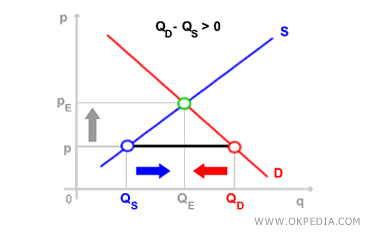Excess Demand
Excess demand refers to an economic situation where the quantity demanded in a market exceeds the quantity supplied. When we consider a demanded quantity QD(p) and a supplied quantity QS(p) for a good, excess demand is represented by the difference QD(p) - QS(p), known as the excess demand function. This function can either be positive or negative.
Positive Excess Demand
Excess demand is considered positive when demand is greater than supply. In this case, consumers are seeking a quantity of the good ( QD ) that exceeds what is available on the market ( QS ).
In a market economy, positive excess demand typically leads to an increase in the price ( p ) of the good. This, in turn, helps to lower demand QD(p) and boost supply QS(p) until the market reaches equilibrium, where QD(pE) equals QS(PE). Positive excess demand can be visualized on a Cartesian graph as follows:

Negative Excess Demand (or Excess Supply)
Excess demand is considered negative when the quantity demanded falls short of the quantity supplied. In this case, consumers are demanding a quantity of the good ( QD ) that is less than what the market is supplying ( QS ). This scenario is also referred to as excess supply.
In a market economy, negative excess demand typically results in a decrease in the price ( p ) of the good. This reduction encourages a decrease in supply QS(p) and an increase in demand QD(p), until the market achieves equilibrium, where QD(pE) equals QS(PE). Negative excess demand can be illustrated on a Cartesian graph as shown:

At market equilibrium, the price level PE balances the quantity of the good demanded QD(pE) with the quantity supplied QS(pE). This price, known as the market equilibrium price, indicates a state where there is no excess demand because QD(p) - QS(p) equals zero.
In this balanced state, the quantity of the good that consumers want to buy exactly matches the quantity that producers are willing to supply. At equilibrium, where QD(p) equals QS(p), excess demand is zero, indicating a perfectly balanced market.
Aggregate Excess Demand
Aggregate excess demand measures the overall surplus in demand for goods and services relative to aggregate supply. In a closed economy, positive aggregate excess demand can be managed in the short term by drawing down inventories, where firms may have previously stored surplus supply, and by increasing the prices (leading to inflation) of goods and services.
In the long term, positive aggregate excess demand can be addressed by investing in productive capacity, allowing the economy to expand and better meet demand over time.
